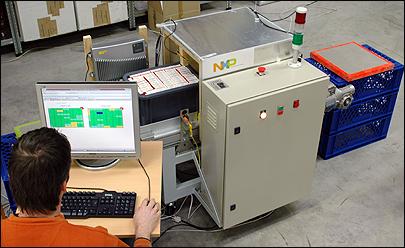Semiconductor firm NXP, spun out last year from Phillips, is determined to get RFID right. To that end, the company has opened the Reference Design Center (RDC), an RFID test center and systems development laboratory in Gratkorn, a town near Graz, Austria. NXP plans to use the RDC as a site for end users to test RFID technology, explains Jan-Willem Reynaerts, the firm’s general manager of RFID. In addition, NXP and other RFID technology vendors can also use it to develop and fine-tune products for specific applications, based on end users’ needs and feedback.
NXP built the 10,000-square-foot center during the past year. Already it has been visited by a number of companies, including European retailer Metro, along with systems integrators and other technology vendors (whom Reynaerts declines to name) to create reference designs for RFID applications. Reference designs offer a blueprint for specific applications, and generally include suggestions regarding the types of tags and readers that should be used; how the hardware should be installed and configured; and how data should be collected, processed, shared and stored by the various parties involved.
While all types of RFID frequencies and standards will be considered as RDC personnel collaborate with technology vendors and end users to develop the reference designs, Reynaerts says the center’s initial work will focus on systems that employ passive UHF (860 to 960 MHz) tags. This, he notes, is largely because passive UHF technology is less mature than RFID systems employing other frequencies, such as high-frequency (13.56 MHz) tags, for which NXP also produces chips. And while the RDC will use tags and readers based on standards issued by EPCglobal and the International Organization for Standardization (ISO), it won’t limit its testing and research to these protocols.
“As we look forward,” Reynaerts says, “we will be using this [RDC] space to work out what a sensor-based tag would look like, for example, and there is no EPCglobal standard for that type of RFID tag today.” One benefit the RDC offers end users of RFID technology, he adds, is the ability to perform very early testing of equipment and workflow so the outcome can be vetted before an end user launches an initial round of pilot tests within its and/or its partners’ facilities.
“We thought it would be good to test UHF technology in a place that would emulate real-world applications,” Reynaerts explains, “and also use the center to create optimized solutions.” He says the RDC provides a venue where end users can test tags and readers designed for specific applications before deciding which to deploy in a pilot project.
“If you look at the passive UHF market today, there is a lot of uncertainty about the technology,” he states. “Companies wonder if they should be using tags [optimized for] near-field UHF reading, whether they should use HF tags for some items, etc.”
While NXP is interested in working with companies from all industries, Reynaerts says, most of the RDC’s early work will involve the creation of reference designs for consumer packaged goods, apparel and pharmaceutical applications. Metro is utilizing the RDC to test a range of UHF RFID tag readers for use in its in warehouses across Germany.
In a statement issued by NXP, Gerd Wolfram, managing director of Metro Group Information Technology (MGI), said the RDC provides “the necessary infrastructure required to evaluate RFID solutions for businesses like ours, including labs, testing equipment and pallet-moving equipments, to re-create the most appropriate real-life conditions.”


